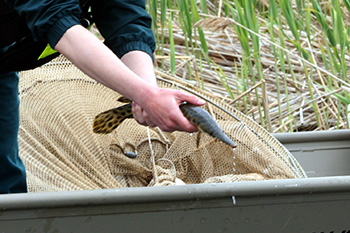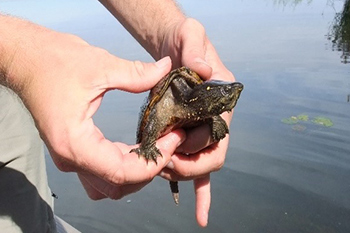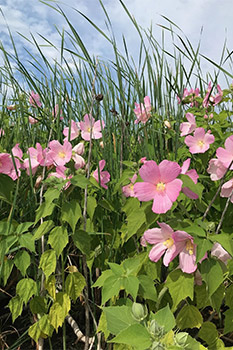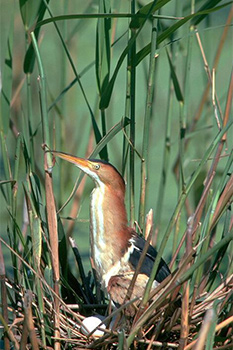
Marsh species
Point Pelee National Park
Below are some of the many species that can be found in the marsh at Point Pelee National Park. Select each species to learn more about how they depend on open water for their survival.
Spotted gar

These endangered fish can be found in coastal wetlands with warm waters and an abundance of aquatic vegetation. They prefer areas with complex, dense vegetation which they use as cover to ambush their prey during nocturnal hunting. They also rely on this vegetation, as well as brush or debris, as a material on which to attach their eggs. Once these eggs hatch, larval young also depend on aquatic vegetation, as they often hang vertically from it or other debris until their yolk-sac is absorbed (within 10 to 13 days). As adults, Spotted Gar feed on smaller fish, like yellow perch and minnows, and crustaceans.
Eastern musk turtle

Eastern musk turtles, also known as stinkpot turtles, spend most of their time in the water. These species at risk prefer shallow water with abundant floating and submerged aquatic vegetation. This habitat allows these turtles to maintain ideal body temperatures without leaving the water. Unlike other turtle species, which can be spotted basking on logs, rocks, and land, eastern musk turtles use floating vegetation as cover to bask in shallow water. As they spend most of their days walking along the soft water bottom, appearing on land only to nest and access nearby wetlands, they are rarely spotted by park visitors despite being year round residents of the marsh. Eastern musk turtles generally hibernate in the mud of the water bottom, but may also use burrows, beaver and muskrat lodges, and the undersides of stumps or rocks near water. They may also use beaver and muskrat lodges as nesting locations, along with decaying vegetation and rotting wood.
In southwestern Ontario, this species has declined substantially and is now restricted to a few tiny, scattered populations.
Swamp rose-mallow

In Canada, this showy perennial is only found in southern Ontario. It usually grows in open, coastal or shoreline marshes, protected from the waves and ice action of the lake by dykes or barrier beaches. However, it can also be found in other wet habitats such as wet woods, thickets, and ditches. Within cattail marshes, like the one in Point Pelee National Park, swamp rose-mallow can be found growing along the edge of the cattail mat where it meets open water. Swamp rose-mallow relies on this edge habitat to provide the combination of organic material, open area, and proximity to water it needs to flourish. It is believed that swamp rose-mallow seeds are distributed by ducks, and that they float around for a while before becoming established. This, in addition to their spread through the movement of floating plant clumps, is what allows this species to survive.
Least bittern

These secretive birds breed in coastal and inland wetlands, where they can hide within tall aquatic vegetation. They build their nests with this vegetation, bending the stems down to form a platform. Least bitterns also require patches of open water to feed. Their diet consists mainly of aquatic species such as small fish, small snakes, frogs, tadpoles, slugs, crayfish and other crustaceans, dragonflies, and leeches. These birds therefore need water in which to hunt, and rarely make their nests further than 10 metres from the edge of cattail mat.
Muskrat

This large rodent lives in freshwater marshes, marshy areas of lakes, and slow-moving streams. Muskrats rely heavily on open water for their diet, feeding primarily on aquatic plants. They also require aquatic plants to construct eating platforms for feeding and nearby lodges. These lodges are used as nests for their young, protection from predators, and as shelter during the winter. Though muskrats are fully functional on land, their buoyant, waterproof fur, large hind feet, and rudder-like tail make them perfectly adapted for their semi-aquatic life-style.
Related links
- Date modified :